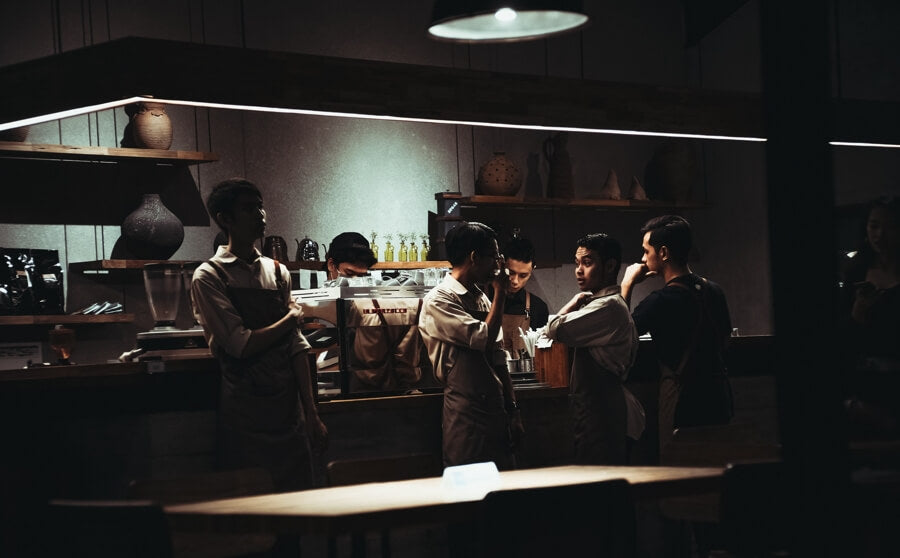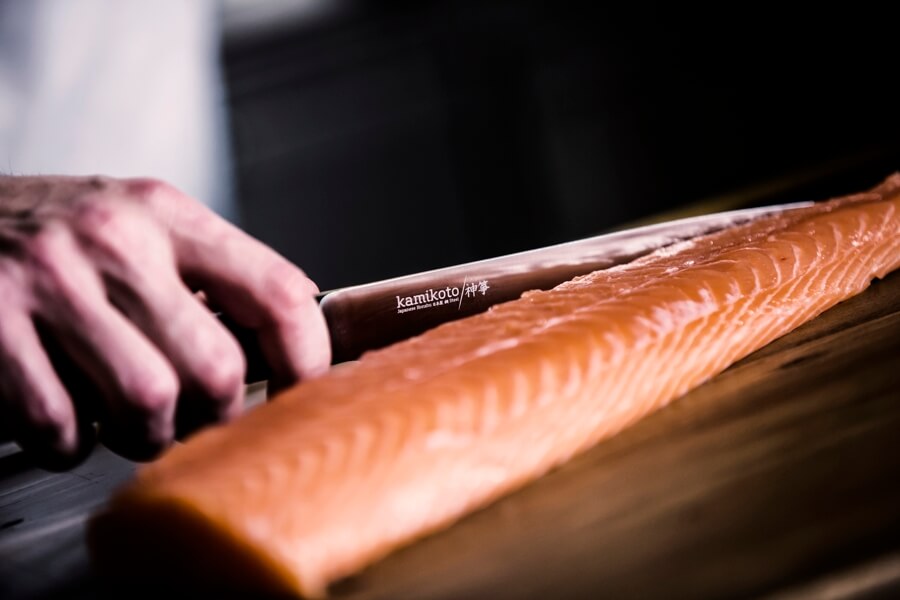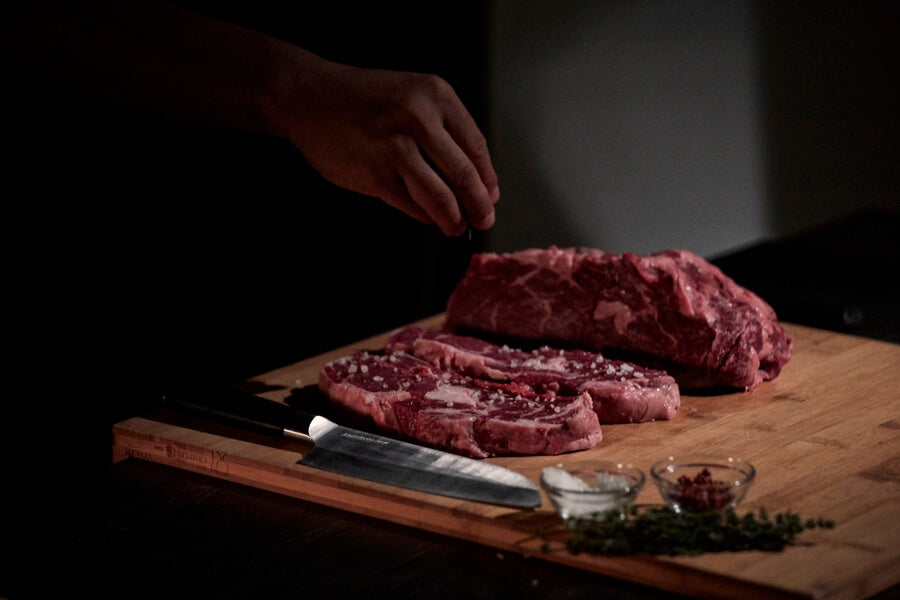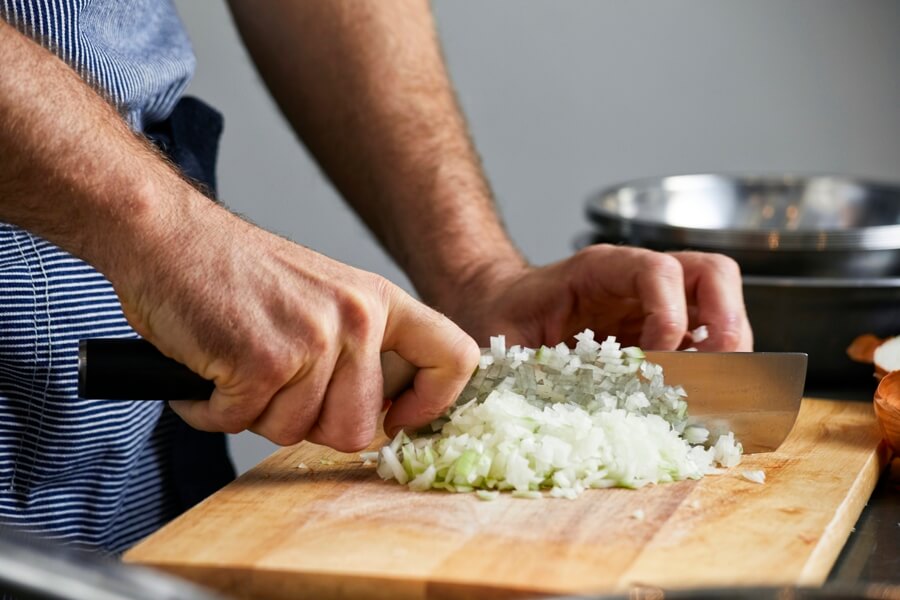
The terms ‘Executive Chef/Chef de Cuisine’ and ‘Sous Chef’ are familiar to most people. The former is responsible for menu planning and runs the kitchen at the most senior level, while the latter oversees all food preparation and manages staff. But there are numerous other careers within a professional kitchen worthy of acclaim and just as essential to the running of such an outfit.
What follows is a depiction of the most common cooking stations within a professional kitchen space, outlining the roles of each chef along with the right tools they need in their culinary arsenal to perform their job to the highest of standards.
The Purpose of Cooking Stations
Historically, large fine-dining kitchens modelled their structure on that of the army or navy where jobs were broken down into clearly defined and structured subdivisions – known as the brigade system.

In cooking, these subdivisions are referred to as ‘stations’ run by a lead chef responsible for reporting back to the executive chef. This structure ensures kitchens work optimally when producing large amounts of dishes to impeccable standards.
Today, not many professional kitchens employ the full brigade system (or all cooking stations). However, many operate on a modified version and retain the traditional names. It is by far the most efficient way of working, especially when one considers the timing needed to execute dishes to a standard worthy of fine dining.
The Types of Cooking Stations
The combination of stations in a kitchen is highly dependent upon two things:
-
The Restaurant’s Cuisine
What food the restaurant cooks and serves dictates the type of cooking stations they need. For example, an upscale seafood restaurant will require a Poissonnier station equipped with a fryer and grill station but will not have any use for a Rotisseur, which is primarily used for roasting meats. Conversely, a restaurant focused on meat such as steaks or prime ribs would have no need for a Poissonnier station.
-
The Size of the Kitchen
Larger establishments, such as grand hotels, operate on a full brigade system with all stations in operation. Smaller restaurants may not have the space, staff or budget to employ such a system so combine multiple stations into one and assign them to a single chef. For instance, the Entremetier station may be responsible for all vegetable, egg and soups dishes rather than relying on a separate Legumier and Potager station.
Here is a brief explanation of some of the most common stations used in professional culinary establishments throughout the world today.
The Saucier Station
As the name implies, a saucier is responsible for the creation of sauces. In some cuisines - such as French - the sauce is the star of the culinary show, bringing together often disparate elements and textures to imbue one harmonious flavor.
In addition to sauces, a saucier also prepares all pan fried and sautéed items (food fried briefly in hot oil or other fat using the technique of ‘jumping’ or ‘bouncing’ the food to avoid it stewing).
There is much scope for creativity in this important role but it is also a highly pressurized one due to the need to adhere to tight time constraints. Sauces can take many hours to perfect and as they are required to finish dishes, the saucier’s timing must be impeccable. Sautéed items are also often done to order so a saucier must be adept at managing competing tasks.
Type of food a saucier cooks:
- Sauces (ie Hollandaise, vinaigrette, Chateaubriand, ponzu, butterscotch, applesauce etc)
- Gravies (rich meat flavored sauces, usually tended to for hours to create a depth of flavor)
- Sautéed items (anything from vegetables to small pieces of meat)
- Hot hors d'oeuvres or appetizers
- Stews
What Equipment does a Saucier Chef need?
Apart from the right set of knives, there are two further essential items in a saucier’s cooking toolkit:
Sauté pan:
Coming in a variety of sizes, a sauté pan is quite shallow with a large, flat bottom and straight sides. The flat bottom ensures there is enough room for all the food to fit in one layer while sautéing, avoiding food over-crowding which leads to stewing and/or steaming. The wide, flat bottom aids in ‘jumping’ the food, a technique many professional sauciers use. It also provides even heat distribution, vital when sautéing food items.
Saucier pan
This is not to be confused with saucepan. Traditional saucepans have deep straight walls with a rounded bottom. Saucier pans offer flared walls with a rounded bowl-shape bottom and a wider mouth. This bowl-like shape is key in producing the finest sauces, allowing the chef whisk and stir constantly without the worry of food catching in corners. These pans are purpose-built for reducing sauces hence their name.
The Poissonnier Station

The name Poissonnier comes from the French word ‘fish’ so it stands to reason this chef is responsible for preparing all fish and seafood dishes. In some kitchens, this includes sourcing fresh fish and seafood each day.
Type of food a Poissonnier cooks:
- Fish
- Seafood
- Accompanying Sauces
What Equipment does a Poissonnier need?
Apart from the correct pots and pans, a possionier’s main ally in the kitchen are the right fish and seafood knives. In some cuisines - such as Japanese - the ability to create the finest fish slices is of utmost importance, both for aesthetics and flavor. Investing in a set such as the Kanpeki Knife Set is paramount to a poissonnier’s trade.
A poissonnier’s knife set should include:
- A Chef or Santoku Knife – perfect for creating fine slices
- A paring knife – ideal for deveining prawns and separating scallops from their shell
- A boning knife – essential for filleting and boning
- An oyster shucker – to enable safe shelling
The Rotisseur Station

The chef in charge of this station must be a culinary meat master. They will be tasked with cooking all red and white meat utilizing a variety of cooking methods. While the name ‘rotisseur’ suggests roasting is the primary one, this is not in fact true. A rotisseur will also grill but often braise meats too, using a quick sear to lock in flavor and then a long, slow roast either on the stove or in the oven.
A rotisseur is highly skilled in the chemical makeup of proteins so fully understands how best to prepare certain cuts to draw out maximum flavor. They may also be in charge of sourcing produce and also employing their supreme knife skills to either butcher or carve meat - or sometimes both.
Type of food a rotisseur cooks:
- all cuts of meat (pork, beef, chicken and other game)
- marinades – must understand which marinades work best with certain meats
What Equipment does a Rotisseur need?
Once again, a keen understanding of kitchen knife types and using the correct ones is of utmost importance here. After all, the right cut has an inordinate amount of impact on the final outcome of the dish.
Some important knives for a rotisseur include:
- A chef or Santoku knife – very versatile in creating anything from fine slices through to rough chops
- A utility knife – similar to the above but more adept at producing even slices
- A cleaver – for chopping large meat bones
- A boning knife – essential for de-boning and butterflying
- A paring knife – good for stripping fine pieces of meat (ie when frenching lamb cutlets)
- A carving knife – produces even slices, preserving the flavor of roasted meats
The Entremetier Station (often includes a Legumier and Potager Station)

Generally speaking, an entremetier is a vegetable chef responsible for the preparation of dishes that do not involve meat, fish or seafood. This includes egg-based dishes. In larger kitchens, an entremetier often runs the station by overseeing both a legumier chef (all vegetable dishes) and a potager chef (all soup-based dishes).
Types of food an entremetier, legumier and potager cooks:
- vegetable-based dishes
- soups
- stock
What Equipment does a Entremetier, Legumier and Potager need?
Aside from essentials such as sauté pans and heavy-based soups pots, the entremetier station should be well-stocked with a wide selection of knives to be able to create the right cuts, particularly when employing finer cutting techniques, such as sengiri to enhance dish presentation in Japanese cuisine or brunoise for consommé.
A recommended selection of knives include:
- A chef or Santoku knife – very versatile in creating anything from fine slices through to rough chops
- A utility knife – similar to the above but more adept at producing even slices
- A cleaver – for chopping large vegetables such as melons
- A paring knife – good for intricate cuts and shaping vegetables for garnish
The Pâtissier Station
A Pâtissier or pastry chef prepares all sweet items including desserts for their restaurant. In smaller kitchens, they may also be tasked with producing pasta, bread and other baked goods. Some larger restaurants or specialty cake shops may also employ a separate decorator responsible for creating sophisticated embellishes for cakes such as chocolate carvings or complicated sugar work.
Type of food a Pâtissier cooks:
- Desserts
- Baked goods including bread
- Pasta
- Decorations for cakes
What Equipment does a Pâtissier need?
For those skilled in the intricate art of pastries, cake making and plated desserts, a full set of kitchen pots, pans and specialty utensils – such as sugar thermometers – is vital. Knife-wise, a chef, paring and bread/cake knife are indispensable both during production of such goods as well as in their sophisticated finishings.
That is a brief inventory of the main cooking stations and their chefs as found in the majority of professional kitchens in restaurants around the world. A finely honed establishment can only be as good as the masters working in their kitchens and as evidenced in this article, each one plays a pivotal role in achieving this.


